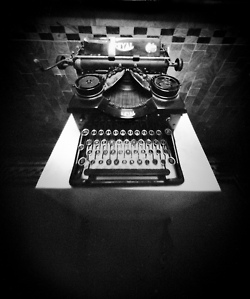Several Clouds Colliding
Following the pair of posts called Railroad Conversations, I thought I might follow on with yet one more book that originated as a public performance, though this book moves away from the subject of railways and deals instead with the life and archive of Emanuel Swedenborg (1688-1772). Published in 2012 by the Swedenborg Archive and Book Works as part of a series, Several Clouds Colliding by Brian Catling and Iain Sinclair is a handsome book that constitutes “part research document, part lecture transcript and part archive intervention” for an exhibition and performance by Catling and Sinclair in 2010.
For decades, archives and museums have been inviting artists and writers to poke around in their collections and respond. It’s a genre that always seems to result in the unexpected, and this is certainly true for Several Clouds Colliding (the title comes from a description of a vision by Swedenborg). In homage to Swedenborg’s visionary writing, Sinclair’s texts are free-form jazz solos, often melancholy and grim. Sinclair, who refers to himself as “the researcher,” realizes the self-reflexive nature of his task. “The researcher, reaching into the tin trunk, reaches into his own portrait, collapses time.” Studying a group portrait of the Swedenborgian Congress of 1910, the researcher tries to forget all the facts he has been told by the archivist. “Invented stories,” he writes, “open fresh neural pathways,” whereas “recitations of confirmed facts, dates, newspaper obituaries, acts of conspicuous clarity, close down the potential for fruitful speculation: new continents, new meanings. If we cannot rewrite the past, we have no future.” For him, “all of these characters with their exotic, shifting names and rigid, mask-like faces played their part in the formulation of the infinite novel.” Sinclair, not surprisingly, finds a history of London as he probes the Swedenborg Archive, “a journey across London curated by angels.” “Researcher as coroner,” he remarks.
Here’s a portion of Sinclair’s text about a typewriter found in the archives that was probably used by the Swedenborg Society.
A scaphocephalic X-ray: top-heavy. The bloodshot eyes are tin reels. Pince-nez of ribbon, legion of dishonour. Rictal mouth in a mash of metallic teeth, German dentistry. Or: standing the thing on its head and the keys become strokes of electrified hair. Shock therapy. One scarlet lip, bitten and bloody. And the other? Black as human ignorance. Bridled, the scold who has swallowed her own children.
 Photograph by Anonymous Bosch.
Photograph by Anonymous Bosch.
Some of the specially commissioned photographs (like the one above) were made by a pinhole photographer called Anonymous Bosch.
Catling takes a more archival, object-based approach, focusing in on the photograph of the 1910 Swedenborgian Congress and a selection of lantern slides from the Society’s teaching collection. In the first instance we see a series of images in which the heads of individuals from the group photograph have been isolated, forming a ghostly cemetery. In the lantern slide collection, Catling became particularly interested in those that are “transforming in that glorious condition normally described as decay.”
How the various parts of the book relate to the exhibition that Catling and Sinclair organized at Swedenborg House is not clear, although the book stands on its own very well. But the book does document the performance they enacted on February 17, 2010 there. As the photographs of the faces attending the Swedenborgian Congress of 1910 were projected, Iain Sinclair took photographs of them with a disposable film camera, which Brian Catling then smashed with a crystal ball so that he could eat the film. Whether the ingestion was consummated or metaphoric is not noted.
It’s possible to get a look at a number of pages from Several Clouds Colliding at the website of the book’s designer James Brook.

